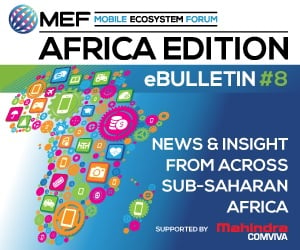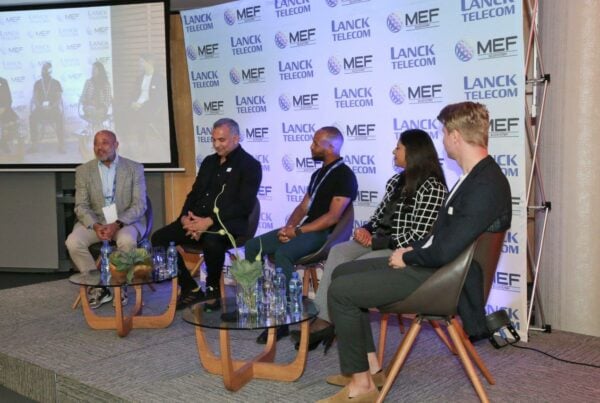The availability of faster networks, cheaper data tariffs and smartphones all have a part to play when it comes to driving demand for Internet services in Sub-Saharan Africa.
According to Analysys Mason, total service revenue across Sub-Saharan Africa will reach USD51.1 billion in 2021, driven by growth opportunities in mobile handset data. Here Karim Yaici, lead analyst for Analysys Mason’s The Middle East and Africa regional research programme, takes a more detailed look the market drivers.
The article originally appeared in MEF’s most recent Africa eBulletin which can be downloaded here for free.
The telecoms market in Sub-Saharan Africa (SSA) is transitioning from one dominated by mobile voice to one driven primarily by the growth of data services. Mobile handset data revenue has strong growth potential across the SSA region, against a backdrop of declining voice revenue, and will increase from USD6.4 billion in 2015 to USD 13.7 billion in 2021 at a CAGR of 13.4 per cent.
This growth will be driven primarily by rising demand for Internet services, the greater availability of low-priced smartphones and expanding 3G and 4G coverage. To realise this growth potential, operators need to address the high cost of data infrastructure deployment in order to support capacity and coverage expansion, as well as introducing affordable and innovative data pricing.
The popularity of social media websites and instant messaging apps (such as Facebook Messenger, Viber, WeChat and WhatsApp), coupled with innovative mobile data offers from operators, continues to stimulate data usage in the region’s mass market segment. Social media bundles (such as Etisalat Nigeria’s ‘smartpaks’ and Zambian operator NetOne’s ‘Easy bundles’) allow access to specific apps and are stimulating data usage.
The increasing availability of low-cost smartphones will remain the primary driver of adoption in the region, as new smartphone brands (mainly from China, such as InnJoo, mi-Fone and Wiko) add to pricing pressure. We believe that smartphones will account for 39.8 per cent of handset connections by 2021.
In addition, partnerships between mobile operators (such as Bharti Airtel, Cell C MTN and Safaricom) and social media platform providers allow zero-rating of data to stimulate data usage. This is encouraging people to use the Internet, as well as accelerating data take-up.
The take-up of smartphones is contributing to this rapid data growth. The region’s smartphone sales will grow at a CAGR of 10.8 per cent between 2015 and 2020, from 63 million units to 105 million units. Smartphones will account for 62.4 per cent of all handset sales in the SSA region in 2020.
The increasing availability of low-cost smartphones will remain the primary driver of adoption in the region, as new smartphone brands (mainly from China, such as InnJoo, mi-Fone and Wiko) add to pricing pressure. We believe that smartphones will account for 39.8 per cent of handset connections by 2021.
Mobile operators are complementing their 3G coverage with LTE to meet consumers’ growing demand for connectivity. 3G’s share of mobile connections in SSA was only 24 per cent in 2015, which leaves operators considerable room for growth as they invest in expansion of their 3G coverage.
LTE is in the early stages of deployment and adoption has so far been limited to the affluent population in urban areas. LTE will help to address the demand for high-speed data and will serve as a catalyst for further smartphone adoption and the growth of mobile data revenue.
Several Internet service providers have emerged in a number of SSA markets to meet the increasing demand for connectivity. These players, including Afrimax, Smile Telecoms, Surfline and Yoomee, are leveraging the ability of LTE to deliver high-speed fixed wireless connectivity in markets where fixed infrastructure has been poor. However, it remains to be seen whether these providers will be able to both acquire sufficient spectrum and scale up to offer comparable speed and prices to mobile operators.
Operators have a significant opportunity to monetise this growing appetite for data. However, disposable income in the region is typically low, which means that affordability will be critical to driving the take-up of data services in the short term. Operators will need to come up with innovative data pricing models that appeal to consumers and encourage usage.
Capital constraints on the supply side could also inhibit operators’ ability to meet increasing demand for data. Operators will need to prioritise alternative options, such as network and tower sharing, in order to mitigate the high cost of deploying and expanding network infrastructure to meet demand for capacity.
For more information download Analysys Mason’s report: Sub-Saharan Africa telecoms market: trends and forecasts 2016–2021.
Download the free MEF Africa eBulletin now
MEF’s quarterly Africa eBulletin contains the insights, market stats, news and opinion that frame the ever-evolving pan-African mobile ecosystem.
The last issue of this eBulletin series looked at the implications of Africa moving past its billionth mobile subscriber and the roll-out of 3G and 4G networks. This time around we turn our attention to some of the services enabled by these advances, as well as the changing landscape of content and messaging.
MEF Member Srinivas Nidugondi, Head of Mobile Financial Solutions at Mahindra Comviva, also provides insight on the enablers and barriers to the adoption of contactless payments by African consumers.








